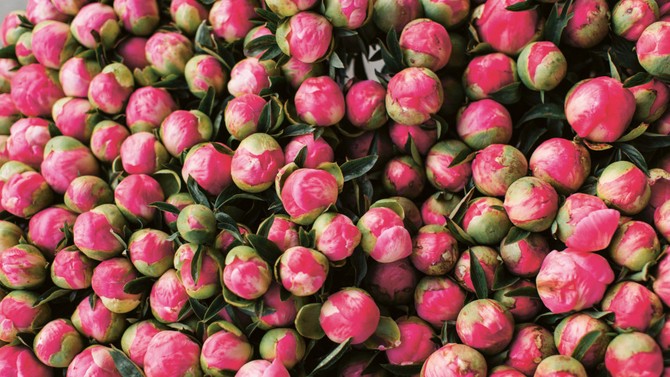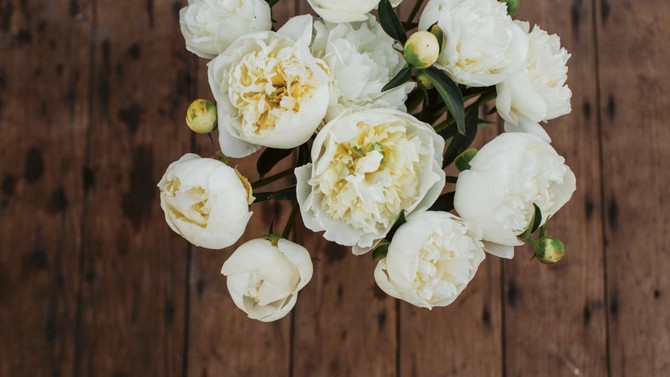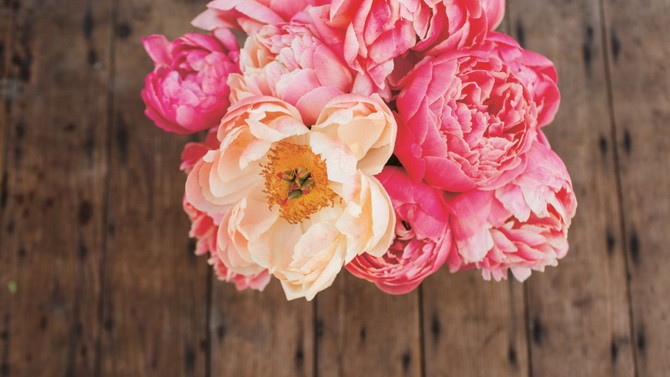4 Things Every Peony Fan Needs to Know
The owner of Floret Flower Farm and author of Cut Flower Garden shares her tricks to making peonies last longer in a vase. Plus, how to grow them yourself!
By Erin Benzakein with Julie Chai

Photo: Michèle M. Waite
Few flowers can contend with the ultimate queen of spring, the peony. Their large flower heads and billowy, ruffled booms come in a dizzying array of pinks, corals, cranberries, whites, yellows, and reds. Many carry a sweet fragrance, and most are long lasting in the vase. It's no wonder they're our most request flowers for weddings and special events.
In addition to being hugely popular and excelling in the vase, peonies are very easy to grow.
How to Grow Peonies
Once established, peonies will flower abundantly for many years. Potted specimens can be purchased and planted in the spring, but the best results will come from bare-root stock that is dug and shipped dormant in the fall. These roots should be planted immediately so that they can start to establish before the cold of winter sets in.
Peonies prefer full sun, and you should give them at least 6 hours of uninterrupted bright daylight. Most soil types are fine, but standing water can be problematic, so be sure to find a spot that has good drainage.
Dig a hole two to three times as wide as the root, and amend the soil with a generous dose of well-rotted manure or compost and a phosphate-rich fertilizer such as bonemeal. Pay special attention to planting depth—if roots are planted too deeply they won't flower properly, so nestle the roots just below the soil surface. These plants will grow large over time, so space them at least 3 feet apart.
In the spring, before the foliage has emerged, top-dress the soil with a sprinkle of bonemeal and a light mulch of compost, 2 inches deep. This will feed the new growth during the coming season.
Double-flowered types need extra staking to keep their flower heads supported under the weight of the massive blooms. Heavy spring rains can flatten a patch in a matter of minutes, so be sure to provide support early on.
It's best to wait 2 to 3 years before harvesting from a newly planted peony; otherwise you may affect its future growth. It's difficult to resist the urge to pick flowers during this time, but the payoff will be a fully mature plant that will reward you with years of blooms.
In addition to being hugely popular and excelling in the vase, peonies are very easy to grow.
How to Grow Peonies
Once established, peonies will flower abundantly for many years. Potted specimens can be purchased and planted in the spring, but the best results will come from bare-root stock that is dug and shipped dormant in the fall. These roots should be planted immediately so that they can start to establish before the cold of winter sets in.
Peonies prefer full sun, and you should give them at least 6 hours of uninterrupted bright daylight. Most soil types are fine, but standing water can be problematic, so be sure to find a spot that has good drainage.
Dig a hole two to three times as wide as the root, and amend the soil with a generous dose of well-rotted manure or compost and a phosphate-rich fertilizer such as bonemeal. Pay special attention to planting depth—if roots are planted too deeply they won't flower properly, so nestle the roots just below the soil surface. These plants will grow large over time, so space them at least 3 feet apart.
In the spring, before the foliage has emerged, top-dress the soil with a sprinkle of bonemeal and a light mulch of compost, 2 inches deep. This will feed the new growth during the coming season.
Double-flowered types need extra staking to keep their flower heads supported under the weight of the massive blooms. Heavy spring rains can flatten a patch in a matter of minutes, so be sure to provide support early on.
It's best to wait 2 to 3 years before harvesting from a newly planted peony; otherwise you may affect its future growth. It's difficult to resist the urge to pick flowers during this time, but the payoff will be a fully mature plant that will reward you with years of blooms.

Photo: Michèle M. Waite
How to Pick Peonies
Peonies make wonderful, long-lasting cut flowers that generally persist for over a week. You can pick them as open as you like, but for the best vase life, harvest them while in bud. I aim for harvesting at the "soft marshmallow" stage—in the mornings I go through the plants and gently squeeze each flower bud, feeling for sponginess. If the buds are still hard, then I leave them to ripen longer, but if they feel soft—similar to a marshmallow—I pick them.

Photo: Michèle M. Waite
The Right Way to Cut Peonies
When harvesting be sure to leave at least 2 sets of leaves on the stem so that the plant can continue to grow and store food over the summer.

Photo: Michèle M. Waite
How to Extend the Life of Peonies (for Later Use)
Cut stems can also be stored for later use; they will last for 2 to 3 weeks in the refrigerator. When storing, remove almost all of the leaves; bunch the stems together, and slip them into a plastic bag with a few paper towels inside to absorb any excess moistures. Lay flat on the shelf in the produce area of the fridge and then check them every few days for signs of mold. Discard any that begin to rot. Upon removal, the flowers often look limp, but don't worry. Recut the stems and place them immediately in warm water with flower preservative. The buds will open within 24 hours, and the blooms will last a good week in the vase.

Excerpted from Floret Farm’s Cut Flower Garden: Grow, Harvest and Arrange Stunning Seasonal Blooms. Text copyright © 2017 by Erin Benzakein and Julie Chai. Photographs © 2017 Michèle M. Waite. Reprinted with permission of Chronicle Books LLC.
Want more stories like this delivered to your inbox? Sign up for the Oprah.com Home & Decorating Newsletter!
Published 05/09/2017

